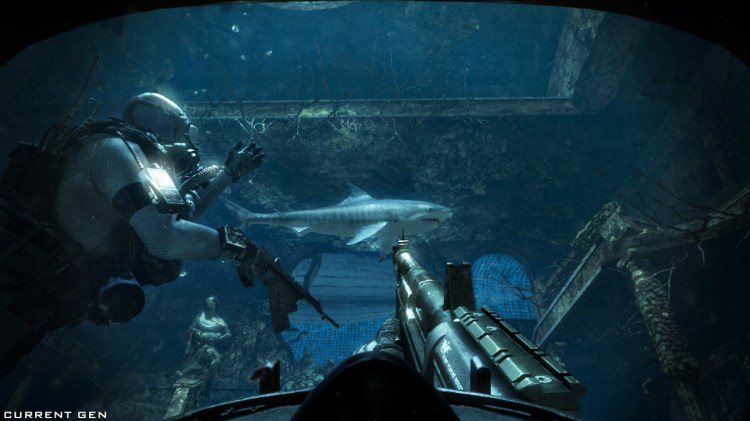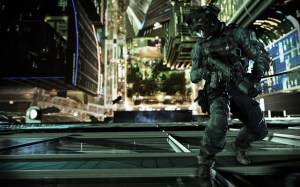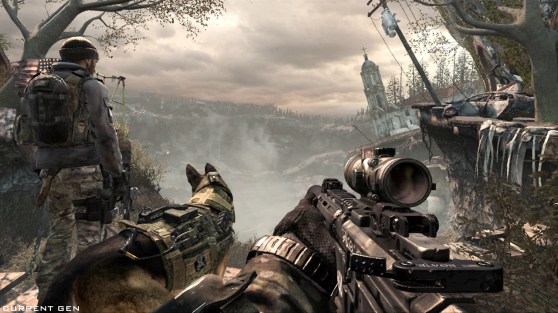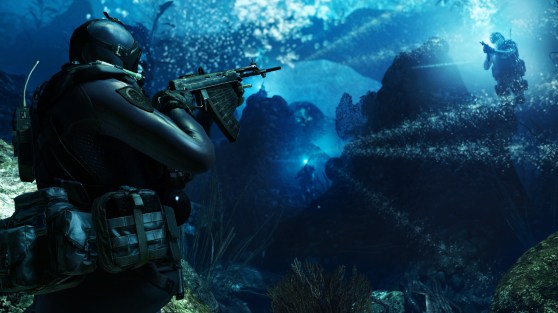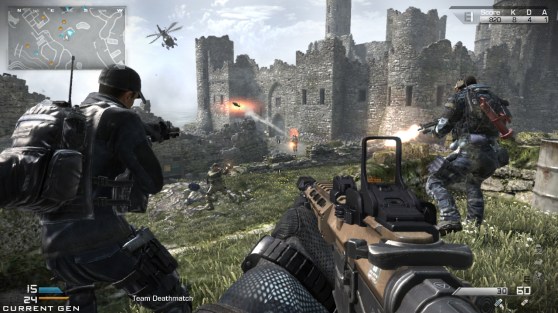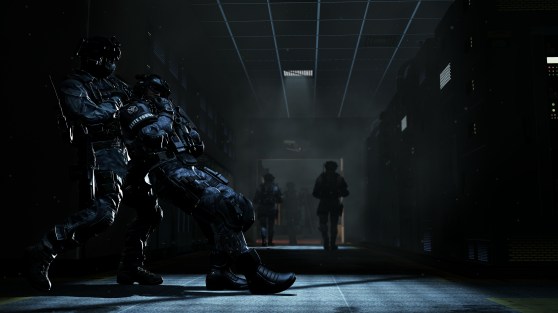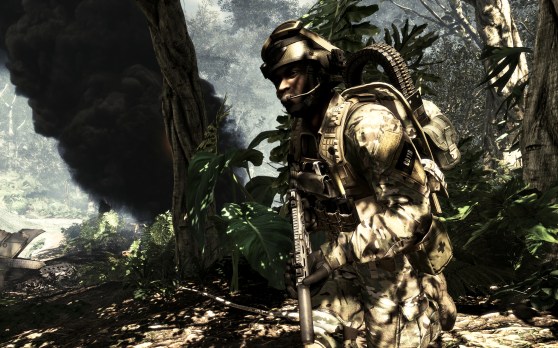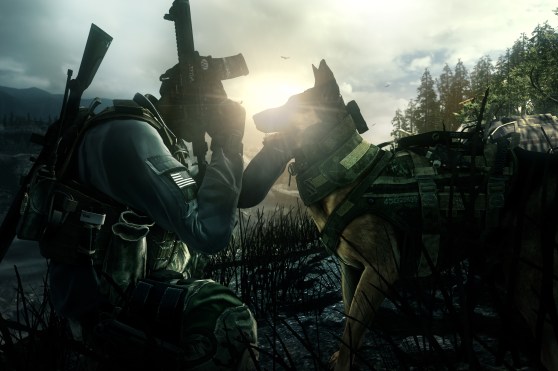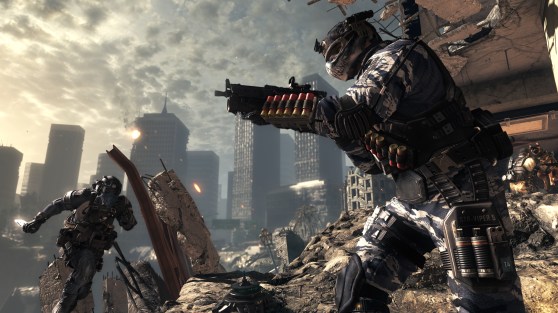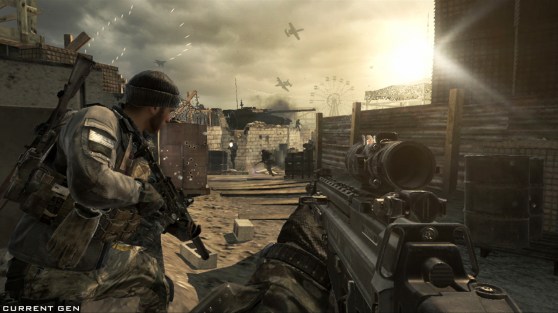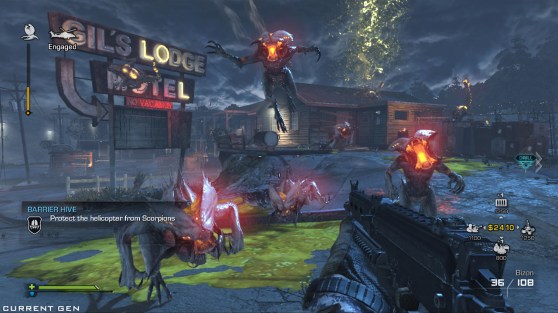Editor’s note: This review has some limited story spoilers.
It had to happen. Call of Duty has been at the top of its game in the first-person-shooter modern-combat genre for years, but in my opinion, the series hit its peak last year with Call of Duty: Black Ops II. Call of Duty: Ghosts, which debuts today on the consoles and the PC, isn’t as good as last year’s game. And it also doesn’t compare favorably to Electronic Arts’ Battlefield 4, at least in my own personal opinion.
Call it gravity. That’s a big problem for publisher Activision Blizzard, which relies on Call of Duty as its blockbuster mature-rated video game franchise. Call of Duty has more than 100 million fans. Every day, gamers around the world play the equivalent of 1,900 years of Call of Duty. They’ve shot down more than 813 million unmanned aerial vehicles (drones) in the game. And they’ve played more than 18 billion multiplayer matches.
Those stats are not indicative of a franchise that is in trouble, and I believe fans are going to keep on playing this year’s Ghosts, too. I don’t think anyone should sit this year out, as players often do with sports games. But if they’re like me, they won’t enjoy Call of Duty as much as they have in years past. I played the Xbox 360 version of Ghosts. The new versions on the upcoming Xbox One and PlayStation 4 consoles will give players a better experience, no doubt. But those consoles will have plenty of competing titles, including some brand-new franchises that will represent some serious competition.
This is the 10th version of Call of Duty, and I’ve been a fan of every one of the games. It is no great crime to fall short of besting last year’s title, as many a franchise has had that problem. But Call of Duty has defied gravity for a very long time by coming up with more spectacular additions to the first-person genre. Its four tenets still include epic realism, great graphics running at a fast 60 frames per second, easy-to-play and hard-to-master, and the ultimate adrenaline rush. This formula has led to growing momentum for the franchise year after year, the very opposite of gravity.
And Ghosts lives up to those tenets.
But this one feels too formulaic, and it even rolls back some of the advances that Treyarch made last year with Black Ops II. Many of the series fans will appreciate the changes. Still more, however, will be puzzled by the growing gulf between the different ways to play a Call of Duty game made by Activision’s Treyarch studio (Black Ops II) and a Call of Duty made by Infinity Ward (Ghosts). These studios are dueling. That’s good for competition. But the danger is that the games could start to feel too different, causing a larger and larger divide within the Call of Duty community.
Call of Duty has already lost its title as the “fastest selling game in history,” as Grand Theft Auto V has taken that honor and isn’t likely to lose it. The threat to is supremacy is real. I’m not alone in this concern about Ghosts, as Cowen & Co. found this summer in its preorder analysis that Call of Duty: Ghosts is tracking well below Black Ops II’s preorder levels from last year. Having played the game, I can see why.
What you’ll like
The action is still awesome
The part that isn’t broken is the familiar over-the-top combat in Ghosts. Trigger-happy gamers are going to find plenty to enjoy. They receive a variety of cool new weapons. You fight in some very exotic places and under very different conditions.
The underwater level is very cool; you have to swim into enemy-controlled waters, avoid sharks, maneuver in a 3D space, and then engage in a firefight with guns that really work underwater. It’s also fun fighting on an oil platform in Antarctica above freezing waters. And then it has a battle where the air is very thin, but we won’t spoil that one for you.
As in most Call of Duty games, the story creates excuses for this military travelogue. A level in Las Vegas is well done, and it’s doubly difficult as you have to protect your dog while fighting. And I love the scene in Venezuela where you are rappelling down the side of a building and looking in the windows, searching for prey. Just as quickly, you get into the building and have to hide in a server room as guards walk by, and then you become the hunted.
The problem with the campaign isn’t that it’s bad. It’s just too short. Maybe six to eight hours in regular mode. But it is good that Infinity Ward leaves you wanting more.
A different story with different characters
Infinity Ward made a big attempt to change the storyline away from Modern Warfare, whose story ran its course over three games.
Part of that effort included bringing in a fresh writer, Hollywood screenwriter Stephen Gaghan, the Academy Award winner for Traffic and the writer and director of Syriana. He concocted a catastrophic surprise attack that turns the U.S. into a permanent underdog and forces it to rely on the stealthy heroics of a few Special Operations survivors, known as Ghosts.
These Ghosts have to fight without all of the high-tech weaponry that they’ve relied on in the past to crush all opposition. They still have access to some cool weapons that you get to use, but they have to go up against enemies with superior firepower and numbers. That leads you down the path of playing stealth, which is more familiar as the hallmark of the Splinter Cell series and isn’t nearly as fun as pitched firefights. You can’t just call in the airstrike, like you can in Battlefield 4.
The new characters include two brothers, Hesh and Logan, and their father, Elias, a surviving military commander. The tight relationship among the family provides for a lot of drama as they try hard to stay alive and protect each other.
The biggest new addition is a dog, Riley. The German Shepherd can respond to your commands that you issue remotely from a tablet to a wireless earphone in the dog’s ear. So you can control the dog, almost as if it were a drone in combat. But the sad thing about Riley is that he may as well be a drone, given his role in the story.
The best thing I can say about the story is that it is different, and it isn’t the same old thing with the same kinds of villains. It makes me appreciate last year’s story and its villain more. But the plot is as preposterous as most stories in Call of Duty games. Those plots tend to be an excuse for trying out a lot of different weapons in exotic locations.
New ways to play multiplayer
Each year, Activision’s studios completely revamp multiplayer combat. This is complicated by the fact that Treyarch has developed its own multiplayer structure for its Black Ops game — and Infinity Ward has now created another structure for Ghosts. That’s a good thing that keeps the game fresh. But it also creates a lot of risk for confusing players, making them divide in preferences along Blacks Ops or Ghosts lines.
But with the onset of the new generation of game consoles, Infinity Ward felt like redoing the multiplayer experience to take advantage of some of the things the new machines can do. It has introduced a new Create-A-Soldier system, where players can mold the physical characteristics of a player, as is possible in most role-playing games. There are 20,000 possible character combinations.
For the first time, you can create a female soldier thanks to the new variety of heads, body types, and equipment. But while women have a role to player in multiplayer, the single-player campaign lacks a female character. That’s like one step up and one step back.
You can also create your own weapon kits using a “perk system,” where you get to spend eight perk points on a variety of features such as “faster reloading.” You can use 11 perk points if you choose not to have a secondary weapon. The perks affect your speed, weapon handling, stealth, battle awareness, resistance, equipment, and your elite senses.
You are also allocated a certain number of points to spend on weaponry.That’s a carryover from last year’s “Pick Ten” feature in Black Ops II. The good thing is that you can create your soldier and your loadout to suit your own tastes from the start in multiplayer. You don’t have to wait to level up and earn a bunch of items first. You can also choose your own Killstreaks, or the rewards you get in a match when you reach a certain number of kills.
As you gain XP, you earn tokens to spend on weapons, attachments, and equipment. You can play different roles on the multiplayer battlefield like Assault, Support, and Specialist. The rewards you get vary based on what category you chose. You can earn a “guard dog” that will warn you when there are nearby enemies and take out enemies that get the jump on you.
The game has 30 new weapons, 20 new Killstreaks, and 14 new multiplayer maps. There are a total of seven new multiplayer modes. The new weapons include Marksman Rifles that are more versatile than sniper rifles but have greater stopping power than assault rifles. In the Search & Rescue mode, you get a single life in a round, but your teammates can revive you if they are nearby. Another new mode is Cranked in Team Deathmatch, which starts a 30-second timer when you get a kill. If you get a kill within the next 30 seconds, you can continue. But if you don’t, you explode. Blitz is another mode where you have to attack or defend a certain piece of turf on the battlefield.
The top ranking in multiplayer is known as Prestige. Last year, you could reach Prestige 10 times. But this time, you can only reach it once, but you can have 10 different soldiers, with each one eligible to reach Prestige. This is one of those confusing cases where it’s not clear to me why the Infinity Ward version has to be different from the Treyarch version of Call of Duty.
Lastly, one of the cool new additions to multiplayer is the “dynamic map event.” These vary from earthquakes that throw off your aim to a trap on the Octane map where you can shoot out the pillars for a gas station platform, causing the roof to fall on anyone below.
I like most of the new features in multiplayer. I just don’t think they add up to a winning result in comparison to last year’s game.
A whole new mode for training and cooperative play
One big addition is the creation of a third mode that blends both single-player and multiplayer. Squads is a nice way to get players on board with multiplayer. In Squads, you can create your own soldiers with the custom configurator from multiplayer play and give them their own unique loadouts of weaponry. Then you can practice multiplayer sessions with them, but with just you as the lone human player fighting with and against squads of artificial intelligence players, or bots. The bots proved to be surprisingly lifelike in their behavior on the field, but I suspect they were a lot easier to kill than real players. But I enjoyed playing with the bots because they helped refine my feel for the weapons, the new multiplayer maps, and the tactics that worked well.
You can play Squads solo, or cooperatively with up to six players. You can also play competitively. The aim is to make the bots indistinguishable from humans. The bots use tactics like side-strafing, corner-camping, and jump-shooting. Your squad can earn experience points, or XP, when you are offline. As another player can challenge your squad in a squad-vs.-squad match. All of the progress you make in Squads counts toward your multiplayer XP.
I actually think that playing in Squads will help me become a better multiplayer player. And I need some help. Last year, with Black Ops II, my kill-to-death ratio was 0.37, meaning I got 37 kills for every 100 of my own deaths.
Another new mode, Extinction, is like the Zombies mode in the Treyarch games. With Extinction, you have to stay alive with your co-op partners against the legions of bugs from hell.
Cool graphics that will shine on next-generation machines
Call of Duty: Ghosts has some beautiful graphics, like the water-distorted underwater imagery in the Deep Dive level. There are also some cool water effects, high grasses, and waterfalls in the jungle terrain. Character animations are more fluid, giving you the ability to pull off moves such as sliding to a crouched or lying position. Your vision is warped when you look through a waterfall. Water mist rises from jungle streams. Even on the Xbox 360, these animations and scenes look beautiful. And they don’t slow the game down.
There are some new moves linked to the better graphics too. There’s a contextual lean system. When you’re on the attack, you can peer around a corner to see what’s on the other side, rather than exposing yourself. You can do “mantling,” or jumping fluidly over objects without losing momentum.
It’s worth pointing out that, even with the graphics I’ve seen on next-generation machines, that Battlefield 4 looks better and it has an advantage over Ghosts with its destructible environment.
A profile that you can move
Among the remaining new features, one of the most useful is the Call of Duty Profile. You can now take your Call of Duty account, either securely through the Call of Duty Elite social network or by signing up for free inside the game, anywhere you want to go. You can move the account from console to console, current-generation machine to next-generation machine, and to second-screen devices. So when you are ready to shift to the Xbox One or PlayStation 4, the process will be easy. And you will see all of your Ghosts stats and in-game achievements show up.
There’s a new Call of Duty App, created by Activision’s Beachhead Studio. The app keeps you connected to the console experience, as you can use it to edit a squad, change loadouts, and view after-action reports. You can share them on Facebook and Twitter. The app will launch alongside the game on tablet and smartphone devices.
Lastly, the Ghosts has a deep level of support for clans. Players can join, create, and manage a clan all from in-game or from the Call of Duty App. From the game, players can view in-game clan rewards, as well as clan vs. clan playlists, which are all available on both current and next gen. Earlier this summer, I played a version of Clan Wars, a clan-based mode that pits clans against each other in a larger global conflict. That seemed pretty cool.
What you won’t like
Battle scenes are too familiar
On the face of it, there are some very cool battle scenes in Call of Duty: Ghosts. You fight on a train. You fight in a jungle river. You fight on a beach. But as interesting as these battles sound and as fun as they are to play, they aren’t original. Uncharted: Among Thieves had a spectacular battle upon a moving train, forcing you to aim carefully as the train swayed back and forth. The experience in Ghosts is quite similar. A battle in zero gravity is quite familiar to anyone who has played the Halo and Killzone games. And the jungle, well, let’s just say just about every game gives you the jungle. And Call of Duty’s jungle scene isn’t as good as others.
These scenes are cool set pieces, like explosive scenes from a blockbuster movie. Unfortunately, other games have done them better. Take the tank battle, for instance. The Call of Duty: Ghosts tanks are really fast, flying around corners at 60 miles per hour. It’s not nearly as realistic as the Battlefield experience, and the tank battle happens far too quickly. On top of that, in the one scene where you get to fight it out in armor, there just aren’t that many enemy tanks available to kill. You spend your time shooting antiaircraft guns. Overall, these tanks were just too fast to be real, and that pops the player out of the sense of immersion. Instead of having fun, you’re wondering why your tank is so fast that you can speed right past enemies and survive their attempts to shoot at you from behind.
The story has the right elements, but it doesn’t come together (spoiler alert)
I found the plot to be fairly implausible. That’s par for the course in Call of Duty games. The enemy of the U.S. is the Federation, a league of South American countries that have gained the upper hand on the U.S. through an act of genocide. But I don’t know where these countries suddenly were able to get together a giant navy or a huge land-based military force that could take on the U.S. Ten years pass from the catastrophe to the game’s action, but it’s still very hard to see how those countries became so powerful as the U.S. became so weak. Again, this part could have been described much better in the short introduction to the game.
If the enemy were the Russians, this scenario could have been much more plausible — especially the parts that have to do with the high-tech nature of the surprise attack. But I suppose the post-Cold War Russia isn’t as good an enemy of the U.S. either. We aren’t fighting Russian communists, Middle East terrorists, or Nazis anymore. This lack of a strong new enemy shows why our love — or at least mine — for these Call of Duty games might be weakening.
In any case, the catastrophe happens so that we can be introduced to the Ghosts, the highly trained badasses who have survived the catastrophe and are now taking the battle to the enemy.
Riley the dog is just as much a character as other major actors in the game. He shows bursts of anger or cowers in fear, and he even whimpers. He adds to the drama in the story. But his role is limited. He’s the centerpiece weapon, so to speak, in a couple of the missions. But the writer doesn’t take full advantage of bringing in the dog as a full character. As such, the dog just fades from memory at a certain point in the game. I wanted to see more Riley in the game, and I didn’t get it. It’s like the writer forgot that we all love dog movies, like Lassie or Old Yeller.
But a worse problem is that the turncoat villain, Rorke, isn’t much of a real villain. You learn that he was once a American Special Operations good guy who became a bad guy, but you don’t really learn that much about how the other villains got him to change sides. He is fierce and somewhat cruel, but he seems no different than other typical Special Operations leaders, taking his aggression out on his troops. Only he is working for the other guys. I didn’t find this to be a believable transition. Rorke is like a running back on a football team who decides to switch sides and play for the others. He’s not the same kind of mad man like Raul Menendez from last year’s Black Ops II. When we learn why he has switched sides, it is narrated to us, not shown to us. So that makes it seem even more implausible.
I don’t know why the seasoned writer would leave out such a pivotal point in the origins of the game’s big villain. So when Rorke does bad things, it seems out of character. We see him as a kind of odd Two-Face character, with a good side and a bad side. It’s even more frustrating that you can’t stop Rorke from doing the bad things when he is determined to do them.
How many times do you have to kill someone?
Ghosts suffers from story characters that really should be dead but aren’t. They get shot in the chest and miraculously recover. You could say that maybe they are wearing body armor. But it happens far too often. So much so that when someone actually dies from wounds, you find it hard to believe. I can’t say more about this problem without spoiling the story. But it ranks high on the list of annoyances for me.
The fact that the writers have to keep the villains around for sequels and later scenes just tells me that they didn’t create enough villains for the game. I really want more. And when I shoot them, I’d prefer they stay dead. It just hurts the suspension of disbelief even more so. And that makes you start thinking that the story for this game isn’t all that it should be.
Some features are missing
It puzzles me that some of the innovations created by Treyarch in Black Ops II are missing from Call of Duty: Ghosts. Namely, the in-game livestreaming from Black Ops II is absent from Ghosts. So is the Theater mode, which enabled you to easily record and share your sessions with friends. But both the PS4 and Xbox One will have built-in livestreaming from Twitch. You’ll just have to use those tools in order to stream your sessions. That’s not a huge loss, but it doesn’t help current-generation owners, and it means that the livestreaming and sharing tools won’t be tailored to Call of Duty.
Ghosts doesn’t have a Zombies or Strike Force mode. I don’t really miss Strike Force, as it was very difficult to play. But Zombies is getting to be so fun that it really just ought to be included in Call of Duty from the outset.
Some of the features seem like they’re missing. But they just have different names. Last year, Treyarch introduced a capture the flag variant dubbed Hardpoint. This year, it’s still there, but Infinity Ward is calling it Blitz.
These guys really have to start talking to each other, just for the sake of continuity. Because their gamers are the same. And we’re getting confused.
It’s not as good as Battlefield 4
I never really thought I’d say that, as EA’s DICE has trailed behind Call of Duty in the past and EA’s Medal of Honor never came close to matching Call of Duty. Battlefield 4 is a lot more gripping from the very start. It is set in China, where there is a new believable enemy. The vehicle combat is grounded in reality, and it’s fun. The environments are destructible in a fun way. And Battlefield 4 has some cool new features like Commander mode, where you can control 32 players on a side in multiplayer combat. You can get into a lot more mayhem.
Conclusion
The bottom line is that, after nine successful titles (though No. 3 was pretty weak), Activision has finally delivered a Call of Duty game that is a disappointment for me. I’ll play it. I’ll enjoy the multiplayer. But I thought that the multiplayer modes for Black Ops II were great. I don’t know why Infinity Ward couldn’t borrow more from those modes and just build upon them.
Call of Duty has grown as a franchise in part because Activision has staffed up its studios so much that they can produce quality games every single year. That has helped the series grow enormously and given it a budget that other game studios would only dream of. But we’ve just crossed the line on one of the risks. And that is that last year’s game was better than this year’s. And that’s a hard thing to recover from.
My hope is that the next-generation versions of this game will be better. I’ve seen them in demos, but I have not played them through yet. But I can’t count on them being better. Nor should gamers who are thinking about playing Battlefield 4 instead. So the current-generation version of Call of Duty: Ghosts may very well get lost in the cornucopia of riches coming for gamers in the holidays. For the game industry, this is a good thing, as we need more variety of hits. But I believe that Activision has its work cut out for it in 2015.
Score: 80/100
Call of Duty: Ghosts releases Nov. 5, 2013, for the PlayStation 3, Xbox 360, the Wii U, and PC. Ghosts will also release later this year on the Xbox One on Nov. 22 and PlayStation 4 on Nov. 15. The publisher provided GamesBeat with an Xbox 360 copy of the game for the purpose of this review.
Which game Are you getting, Battlefield 4 or Call of Duty: Ghosts? Take our poll. And check out our screenshots below.
VentureBeat's mission is to be a digital town square for technical decision-makers to gain knowledge about transformative enterprise technology and transact. Learn More
